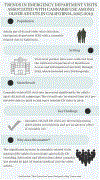Trends in emergency department visits associated with cannabis use among older adults in California, 2005-2019
- PMID: 36622838
- PMCID: PMC10089945
- DOI: 10.1111/jgs.18180
Trends in emergency department visits associated with cannabis use among older adults in California, 2005-2019
Abstract
Background: The use of cannabis among older adults is increasing in the United States. While cannabis use has been suggested to help alleviate chronic symptoms experienced by older adults, its potential adverse effects may lead to unintended consequences, including increased acute healthcare utilization related to its use. The objective of this study was to examine trends in cannabis-related emergency department (ED) visits in California.
Methods: Using data from the Department of Healthcare Access and Information, we conducted a trend analysis of cannabis-related ED visits from all acute care hospitals in California from 2005 to 2019. For each calendar year, we determined the cannabis-related ED visit rate per 100,000 ED visits for adults aged ≥65 utilizing primary or secondary diagnosis codes. We estimated the absolute and relative changes in overall cannabis-related visit rates during the study period and by subgroup, including age (65-74, 75-84, ≥85), race/ethnicity, sex, payer/insurance, Charlson comorbidity index score, and cannabis-related diagnosis code.
Results: The cannabis-related ED visit rate increased significantly for adults aged ≥65 and all subgroups (p < 0.001). The overall rate increased from 20.7 per 100,000 visits in 2005 to 395.0 per 100,000 ED visits in 2019, a 1804% relative increase. By race/ethnicity, older Black adults had the highest ED visit rate in 2019 and the largest absolute increase while older males had a higher ED visit rate in 2019 and a greater absolute increase than older women. Older adults with a higher Charlson score had a higher ED visit rate in 2019 and a larger absolute increase during the study period.
Conclusion: Cannabis-related ED visits are increasing among older adults in California and are an adverse effect of cannabis use. Asking about cannabis use and providing education about its use should be a part of routine medical care for older adults.
Keywords: cannabis; emergency department; marijuana; substance use.
© 2023 The American Geriatrics Society.



